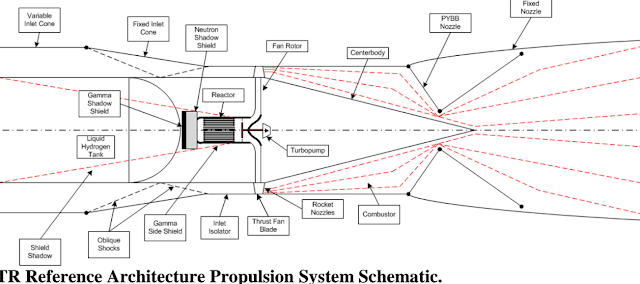The Nuclear Thermal Turbo Rocket - A Conceptual High-Performance Earth-to-Orbit Propulsion System by John Bucknell
A new propulsion concept called the Nuclear Thermal Turbo Rocket (NTTR) is proposed for Earth to Orbit applications. The NTTR utilizes a nuclear fission reactor to thermally heat hydrogen propellant into a rocket plenum. The rocket nozzles are located at the tips of a variable pitch thrust fan connected to the plenum by passages in the fan blades, and each nozzle is a linear aerospike on the trailing edge of the blade. The thrust fan is located in a duct such that the heated hydrogen propellant is combusted with ambient sourced oxygen to augment the rocket thrust. The fan is of variable pitch to provide maximum thrust for varying inlet velocity. The duct has a variable geometry inlet, able to provide appropriate mass flow and compression to the combustor throughout the trajectory, and a variable geometry outlet to provide appropriate nozzle area for maximum thrust. The rocket nozzles act as propellant injectors during the airbreathing portion and pure rockets during low atmospheric density portions, with the NTTR utilizing a single gas path from launch to orbital velocity. The propulsion concept is of high performance and is able to transport more than 50% mass fraction in a Single Stage to Orbit (SSTO) via an air-breathing rocket trajectory with intended complete reusability. Payload fractions of up to 19% are predicted (inert mass includes reactor radiation shielding) due to a mission average Specific Impulse (Isp) of 1,662 seconds.
Examining the shortcomings of prior concepts and systematically integrating major features of existing technical work is the innovation pathway. What is desired is a propulsion system capable of SSTO for highest reusability simultaneously with highest mass fraction delivered for lowest operational costs so as to minimize access to orbit costs. Nuclear thermal rockets already offer the highest Isp of launch-capable pure rocket propulsion systems, whereas the Supercharged Ejector Scramjet (SESJ, Ref. 8) and afterburning supersonic Rocket Fan are the highest launch to hypersonic Isp chemical combined cycle systems proposed so it is logical to attempt to integrate those cycles. The Rocket Fan study predates a later study where the performance of Supersonic Through-Flow Fans (STFF) was expanded and detailed by adding variable pitch fan capability with enhanced low speed thrust and reduced mass as compared to Airturbo Ramjet solutions for Mach 5 cruise applications. RBCC solutions typically use the supercharging fan only for subsonic or low supersonic augmentation, whereas STFFs can operate with fan face Mach numbers from 0 to around 4.5. Air-augmented nuclear rockets are only mentioned once in the literature – the Nuclear Air-Enhanced Rocket (NEAR) which is a ducted rocket that performed as an ejector rocket and ramjet.
The new proposed propulsion concept is called the Nuclear Thermal Turbo Rocket (NTTR), which is a supercharged air-augmented nuclear thermal rocket architecture. It operates in rocket fan, ramjet, scramjet and pure rocket modes.
Read more »![]()
A new propulsion concept called the Nuclear Thermal Turbo Rocket (NTTR) is proposed for Earth to Orbit applications. The NTTR utilizes a nuclear fission reactor to thermally heat hydrogen propellant into a rocket plenum. The rocket nozzles are located at the tips of a variable pitch thrust fan connected to the plenum by passages in the fan blades, and each nozzle is a linear aerospike on the trailing edge of the blade. The thrust fan is located in a duct such that the heated hydrogen propellant is combusted with ambient sourced oxygen to augment the rocket thrust. The fan is of variable pitch to provide maximum thrust for varying inlet velocity. The duct has a variable geometry inlet, able to provide appropriate mass flow and compression to the combustor throughout the trajectory, and a variable geometry outlet to provide appropriate nozzle area for maximum thrust. The rocket nozzles act as propellant injectors during the airbreathing portion and pure rockets during low atmospheric density portions, with the NTTR utilizing a single gas path from launch to orbital velocity. The propulsion concept is of high performance and is able to transport more than 50% mass fraction in a Single Stage to Orbit (SSTO) via an air-breathing rocket trajectory with intended complete reusability. Payload fractions of up to 19% are predicted (inert mass includes reactor radiation shielding) due to a mission average Specific Impulse (Isp) of 1,662 seconds.
Examining the shortcomings of prior concepts and systematically integrating major features of existing technical work is the innovation pathway. What is desired is a propulsion system capable of SSTO for highest reusability simultaneously with highest mass fraction delivered for lowest operational costs so as to minimize access to orbit costs. Nuclear thermal rockets already offer the highest Isp of launch-capable pure rocket propulsion systems, whereas the Supercharged Ejector Scramjet (SESJ, Ref. 8) and afterburning supersonic Rocket Fan are the highest launch to hypersonic Isp chemical combined cycle systems proposed so it is logical to attempt to integrate those cycles. The Rocket Fan study predates a later study where the performance of Supersonic Through-Flow Fans (STFF) was expanded and detailed by adding variable pitch fan capability with enhanced low speed thrust and reduced mass as compared to Airturbo Ramjet solutions for Mach 5 cruise applications. RBCC solutions typically use the supercharging fan only for subsonic or low supersonic augmentation, whereas STFFs can operate with fan face Mach numbers from 0 to around 4.5. Air-augmented nuclear rockets are only mentioned once in the literature – the Nuclear Air-Enhanced Rocket (NEAR) which is a ducted rocket that performed as an ejector rocket and ramjet.
The new proposed propulsion concept is called the Nuclear Thermal Turbo Rocket (NTTR), which is a supercharged air-augmented nuclear thermal rocket architecture. It operates in rocket fan, ramjet, scramjet and pure rocket modes.
Read more »
